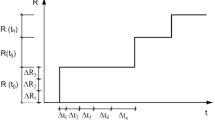Abstract
Optimization algorithms that have recently become available in computer libraries revolutionize checking and identification of theoretical creep laws from test data. Much more detailed comparisons with creep test data are now feasible, and with little effort. Formulating the optimality condition in terms of a sum-of-squares objective function and expressing various positiveness constraints by quadratic substitutions, one can apply the Marquardt algorithm. In this manner, two recently proposed formulations are examined: (a) the viscoelastic model with reduced time, and (b) the rate-of-flow method. It is shown that none of these formulations is capable of giving a satisfactory description of creep data which cover the full range of interest in creep durations and ages at loading, even though an acceptable agreement has previously been demonstrated for creep data of narrow time range. Previously it has been found by the same method that the recently proposed creep formulation for C.E.B. Recommendations suffers by the same limitations. That formulation and the two formulations examined herein share the underlying concept of separating the total creep strain in reversible creep and irreversible creep. The present demonstrate that this (theoretically unfounded) concept is contradicted by creep data of not too limited time range.
Résumé
La vérification et l'identification des lois théoriques de fluage à partir des résultats d'essai se trouvent renouvelées par les algorithmes d'optimisation depuis peu disponibles dans les informathèques. On peut, à présent, opérer des comparaisons bien détaillées avec les résultats d'essais de fluage, et cela sans trop de peine. En formulant les conditions d'optimalité dans les termes d'une fonction objective de somme des carrés, et en exprimant par des substitutions quadratiques des contraintes de différentes valeurs positives, on peut appliquer l'algorithme de Marquardt. C'est de cette façon qu'on étudie ici deux formulations récemment proposées: (a) le modèle viscoélastique avec réduction du temps, et (b) la méthode de la «vitesse de déformation plastique».
On sait qu'aucune de ces formulations ne peut bien rendre compte des résultats d'essai de fluage pour toute l'étendue des valuers intéressantes de durée de fluage et d'âge de chargement, bien qu'on ait précédemment obtenu une certaine concordance avec les résultats d'essai dans un intervalle restreint. Cette même méthode a fait déjà révéler que la formulation du fluage récemment proposée par les Recommandations du C.E.B. était entachée des mêmes limitations. Celle-ci, ainsi que les deux formulations qu'on étudie ici ont en commun le même concept sous-jacent de séparation de la déformation totale de fluage en fluage réversible et fluage irréversible. Nos résultats démontrent que ce concept est en contradiction avec les résultats de fluage obtenus dans un intervalle de temps qui ne soit pas trop limité.
Similar content being viewed by others
References
Bažant Z. P., Osman E.—On the choice of creep function for standard recommendations on pratical analysis of structures. Cement and Cone rete Research, Vol. 5, 1975, pp. 129–138, with Discussion by H. Rüsch, D. Jungwirth, H. Hilsdorf and Authors' Reply, Vol. 5, pp. 631–641; Vol. 6, 1976, pp. 149–157.
Bažant Z. P.—Theory of creep and shrinkage in concrete structures: A précis of recent developments. Mechanics Today, Vol. 2, 1975, pp. 1–93 (ed by S. Nemat-Nasser), Pergamon Press, New York.
Bažant Z. P.—Prediction of concrete creep effects using age-adjusted effective modulus method. Amer. Concrete Institute J., Vol. 69, 1972, pp. 212–217.
Bažant Z. P., Osman E.—Double power law for basic creep of concrete. Materials and Structures (RILEM, Vol. 9, No. 49, 1976, pp. 3–11.
Constantinescu D. R., Illston J. M.—Direct method of analysing the structural effects of linear creep of aging concrete, Materials and Structures (RILEM), Vol. 7, 1974, pp. 395–401.
Constantinescu D. R., Illston J. M.—Direct solutions to problems of time-dependent induced stresses in restrained concrete. Materials and Structures (RILEM), Vol. 8, 1975, pp. 11–17.
Gamble B. R., Jordaan I. J.—A direct method of viscoelastic analysis of ageing concrete. Materials and Structures (RILEM), Vol. 7, No. 37, 1974, p. 37–43.
Hanson J. A.—A 10-year study of creep properties of concrete. Concrete Laboratory Report No. Sp-38, U.S. Department of the Interior. Bureau of Reclamation. Denver, 1953.
Harboe E. M. et al.—A comparison of the instantaneous and the sustained modulus of elasticity of concrete. Concrete Laboratory Report No. C-854, Division of Engineering Laboratories, U.S. Department of the Interior, Bureau of Reclamation, Denver, 1958.
Jordaan I. J.—A note on concrete creep analysis under static temperature fields. Materials and Structures (RILEM), Vol. 7, No. 41, 1974, pp. 329–333.
L'Hermite R., Mamillan M., Lefèvre C.—Nouveaux résultats de recherches sur la déformation et la rupture du béton. Annales de l'Institut technique du bâtiment et des travaux publics, Vol. 18, No. 207-208, 1965, pp. 325–360; and a table of data privately communicated by Mamillan, 1971.
Pirtz D.—Creep characteristics of mass concrete for Dworshak dam. Report No. 65-2, Structural Engineering Laboratory, Univ. of California, Berkeley, California, 1968.
Rüsch H., Jungwirth D., Hilsdorf H.—Kritische Sichtung der Verfahren zur Berücksichtigung der Einflüsse von Kriechen, Beton-und Stahlbetonbau, Vol. 68, 1973, pp. 49–60, 76–86, 152–158.
Author information
Authors and Affiliations
Rights and permissions
About this article
Cite this article
Bažant, Z.P., Thonguthai, W. Optimization check of certain recent practical formulations for concrete creep. Mat. Constr. 9, 91–98 (1976). https://doi.org/10.1007/BF02473864
Issue Date:
DOI: https://doi.org/10.1007/BF02473864




